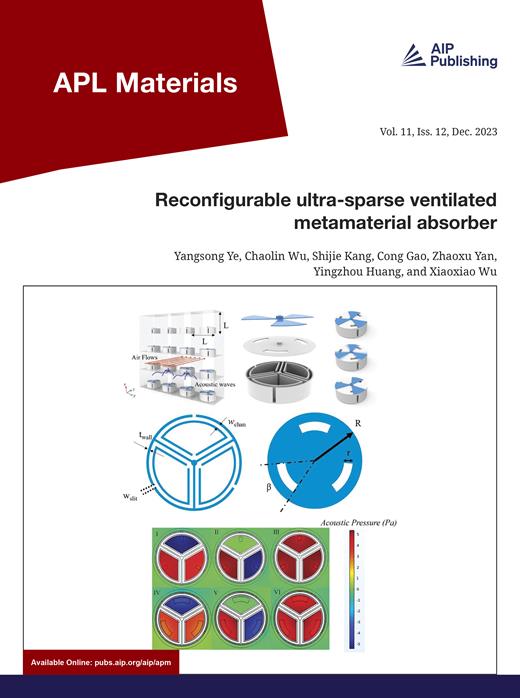Microgel-based etalon membranes: Characterization and properties
IF 5.3
2区 材料科学
Q2 MATERIALS SCIENCE, MULTIDISCIPLINARY
引用次数: 0
Abstract
We introduce Microgel-based Etalon Membranes (MEMs), based on the combination of stimuli-responsive microgels with an etalon, which is an optical device consisting of two reflecting plates and is used to filter specific wavelengths of light. The microgels are sandwiched between two reflective layers and, in response to a stimulus (e.g., temperature, pH, or biomarker concentration), swell or de-swell, thereby changing the distance between the two reflective layers and generating multiple peaks in the reflectance spectra. This property gives a MEM the unique capability of simultaneous separation and tunable responses to environmental changes and/or biomarker concentrations. We propose a design based on gold layers on a silicon nitride wafer membrane. Our comprehensive characterization, employing permeability experiments, in situ optical reflectance spectroscopy, in-liquid atomic force microscopy (AFM) analysis, and captive bubble contact angle measurements, elucidates the dynamic response of MEM to pH, temperature, and glucose stimuli and the corresponding effect of microgel swelling/de-swelling on the membrane properties, e.g., permeability. The AFM results confirm the dynamic changes of the microgel layer’s thickness on the membrane surface in response to the stimuli. Although the microgel’s swelling/de-swelling influences the effective pore radius, the decrease in the membrane’s permeance is limited to less than 10%. In the swollen state of the microgels, the etalon membranes show a prominent hydrophilic behavior, while they become less hydrophilic in the microgels’ de-swollen state. This work introduces MEM and provides novel insights into their behavior. The fundamental understanding that we reveal opens the way to applications ranging from point-of-care testing to continuous environmental monitoring.基于微凝胶的等离子膜:表征和特性
我们介绍了基于微凝胶的埃特隆膜(MEM),其基础是刺激响应型微凝胶与埃特隆的结合,埃特隆是一种由两个反射板组成的光学设备,用于过滤特定波长的光。微凝胶夹在两个反射层之间,在受到刺激(如温度、pH 值或生物标记物浓度)时,会膨胀或脱泡,从而改变两个反射层之间的距离,在反射光谱中产生多个峰值。这种特性使 MEM 具备了同时分离和对环境变化和/或生物标记物浓度做出可调响应的独特能力。我们提出了一种基于氮化硅晶片膜上金层的设计。我们采用渗透性实验、原位光学反射光谱、液态原子力显微镜(AFM)分析和俘获气泡接触角测量等综合表征方法,阐明了 MEM 对 pH 值、温度和葡萄糖刺激的动态响应,以及微凝胶膨胀/脱膨胀对膜特性(如渗透性)的相应影响。原子力显微镜的结果证实了膜表面微凝胶层的厚度在刺激下的动态变化。虽然微凝胶的溶胀/脱溶胀会影响有效孔半径,但膜渗透率的降低幅度却小于 10%。在微凝胶的膨胀状态下,乙撑膜表现出突出的亲水性,而在微凝胶的消肿状态下,它们的亲水性则变弱。这项研究介绍了 MEM,并对其行为提出了新的见解。我们所揭示的基本认识为从护理点测试到连续环境监测等各种应用开辟了道路。
本文章由计算机程序翻译,如有差异,请以英文原文为准。
求助全文
约1分钟内获得全文
求助全文
来源期刊

APL Materials
NANOSCIENCE & NANOTECHNOLOGYMATERIALS SCIE-MATERIALS SCIENCE, MULTIDISCIPLINARY
CiteScore
9.60
自引率
3.30%
发文量
199
审稿时长
2 months
期刊介绍:
APL Materials features original, experimental research on significant topical issues within the field of materials science. In order to highlight research at the forefront of materials science, emphasis is given to the quality and timeliness of the work. The journal considers theory or calculation when the work is particularly timely and relevant to applications.
In addition to regular articles, the journal also publishes Special Topics, which report on cutting-edge areas in materials science, such as Perovskite Solar Cells, 2D Materials, and Beyond Lithium Ion Batteries.
 求助内容:
求助内容: 应助结果提醒方式:
应助结果提醒方式:


